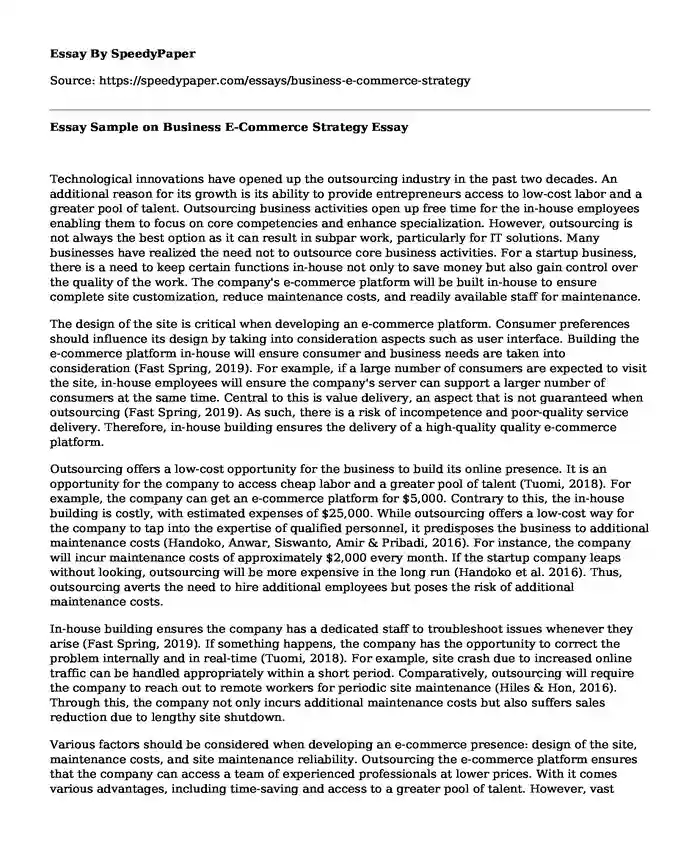
| Type of paper: | Research paper |
| Categories: | Information technologies Software Business strategy |
| Pages: | 3 |
| Wordcount: | 685 words |
Technological innovations have opened up the outsourcing industry in the past two decades. An additional reason for its growth is its ability to provide entrepreneurs access to low-cost labor and a greater pool of talent. Outsourcing business activities open up free time for the in-house employees enabling them to focus on core competencies and enhance specialization. However, outsourcing is not always the best option as it can result in subpar work, particularly for IT solutions. Many businesses have realized the need not to outsource core business activities. For a startup business, there is a need to keep certain functions in-house not only to save money but also gain control over the quality of the work. The company's e-commerce platform will be built in-house to ensure complete site customization, reduce maintenance costs, and readily available staff for maintenance.
The design of the site is critical when developing an e-commerce platform. Consumer preferences should influence its design by taking into consideration aspects such as user interface. Building the e-commerce platform in-house will ensure consumer and business needs are taken into consideration (Fast Spring, 2019). For example, if a large number of consumers are expected to visit the site, in-house employees will ensure the company's server can support a larger number of consumers at the same time. Central to this is value delivery, an aspect that is not guaranteed when outsourcing (Fast Spring, 2019). As such, there is a risk of incompetence and poor-quality service delivery. Therefore, in-house building ensures the delivery of a high-quality quality e-commerce platform.
Outsourcing offers a low-cost opportunity for the business to build its online presence. It is an opportunity for the company to access cheap labor and a greater pool of talent (Tuomi, 2018). For example, the company can get an e-commerce platform for $5,000. Contrary to this, the in-house building is costly, with estimated expenses of $25,000. While outsourcing offers a low-cost way for the company to tap into the expertise of qualified personnel, it predisposes the business to additional maintenance costs (Handoko, Anwar, Siswanto, Amir & Pribadi, 2016). For instance, the company will incur maintenance costs of approximately $2,000 every month. If the startup company leaps without looking, outsourcing will be more expensive in the long run (Handoko et al. 2016). Thus, outsourcing averts the need to hire additional employees but poses the risk of additional maintenance costs.
In-house building ensures the company has a dedicated staff to troubleshoot issues whenever they arise (Fast Spring, 2019). If something happens, the company has the opportunity to correct the problem internally and in real-time (Tuomi, 2018). For example, site crash due to increased online traffic can be handled appropriately within a short period. Comparatively, outsourcing will require the company to reach out to remote workers for periodic site maintenance (Hiles & Hon, 2016). Through this, the company not only incurs additional maintenance costs but also suffers sales reduction due to lengthy site shutdown.
Various factors should be considered when developing an e-commerce presence: design of the site, maintenance costs, and site maintenance reliability. Outsourcing the e-commerce platform ensures that the company can access a team of experienced professionals at lower prices. With it comes various advantages, including time-saving and access to a greater pool of talent. However, vast drawbacks are associated with outsourcing, including high maintenance costs and lack of customization, inferring that it is not ideal for a startup company. The need to build the e-commerce platform in-house is to ensure site customization, low maintenance costs and ready access to staff for periodic maintenance.
References
Fast Spring. (2019). In-House or Outsourced: Which Ecommerce Solution is best for Your Business? Fast Spring. Retrieved from https://fastspring.com/blog/in-house-outsourced-ecommerce-solution-best-business/
Handoko, B., Anwar, S., Siswanto, H., Amir, M. F., & Pribadi, R. (2015, October). Building an in-house CMMS to simplify maintenance management in an oil and gas company. In SPE/IATMI Asia Pacific Oil & Gas Conference and Exhibition. Society of Petroleum Engineers.
Hiles, A., & Hon, F. B. C. I. (2016). E-business service level agreements: Strategies for service providers, e-commerce and outsourcing. Rothstein Publishing.
Tuomi, K. (2018). The Technology Trade-Off: The Cost of Software Development and its Implications for Start-Ups. School of International Service Research Paper, (2017-2).
Cite this page
Essay Sample on Business E-Commerce Strategy. (2023, Feb 22). Retrieved from https://speedypaper.com/essays/business-e-commerce-strategy
Request Removal
If you are the original author of this essay and no longer wish to have it published on the SpeedyPaper website, please click below to request its removal:
- Gender Socialization Essay Sample
- Effective Human Relations Communications Style Assessment Exercise Example
- Cultural Diversity Scenario in Education, Free Essay Sample
- Is Child Behavior Better or Worse than It Was Years Ago? Free Essay Provides the Answer
- Paper Example on Strategic Analysis of Oman Oil Company
- Above all, I would very much like to express my gratitude to God for standing by me and being the cause for my being and gifted myself with His abundant refinement to finish this broadsheet fruitfully. Yours truly's great thanks toward my mentor for bestowing commentaries worthily beside his generous direction in the course of this study work. Then my heartfelt indebtedness toward my entire family and all my friends for their never-ending backing, affection, and encouragement throughout my research.
- Free Essay. Enterprise Resource Planning Program
Popular categories




